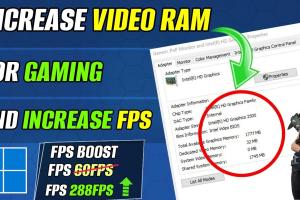Boosting Performance: A Comprehensive Guide to Increasing Dedicated Video RAM on Windows Laptops with Intel Graphics

-
Quick Links:
- Introduction
- What is Dedicated Video RAM?
- Why Increase Dedicated Video RAM?
- How to Check Your Current Video RAM
- Methods to Increase Dedicated Video RAM
- Using BIOS Settings
- Using Intel Graphics Command Center
- Using Windows Registry Editor
- Case Studies and Real-World Examples
- Expert Insights on Video RAM Management
- Common Misconceptions About Video RAM
- Conclusion
- FAQs
Introduction
In today's digital landscape, the demand for high-performance laptops is greater than ever. Whether you're a gamer, a video editor, or simply someone who enjoys a seamless viewing experience, understanding how to optimize your laptop's performance is crucial. One way to enhance the graphical capabilities of your Windows laptop is by increasing the dedicated video RAM (VRAM) allocated to your Intel Graphics.
What is Dedicated Video RAM?
Dedicated Video RAM is a type of memory specifically reserved for your laptop's graphics processing unit (GPU). Unlike shared memory, which uses a portion of your system RAM, dedicated VRAM provides a more efficient way for your laptop to handle graphics-intensive tasks. This is particularly important for gaming, graphic design, and video editing applications.
Why Increase Dedicated Video RAM?
Increasing dedicated video RAM can significantly improve the performance of your laptop in various scenarios:
- Enhanced Gaming Experience: More VRAM allows for higher texture quality and smoother frame rates.
- Better Video Editing: Video editing software often requires substantial VRAM to handle large files and effects.
- Improved Multitasking: Increased VRAM can help when running multiple applications that require graphical processing.
How to Check Your Current Video RAM
Before making any changes, it's essential to know how much dedicated video RAM your laptop currently has. Here's how to check:
- Right-click on your desktop and select Display settings.
- Scroll down and click on Advanced display settings.
- Select Display adapter properties for your display.
- In the Adapter tab, look for Dedicated Video Memory.
Methods to Increase Dedicated Video RAM
There are several methods to increase the dedicated video RAM on your Windows laptop with Intel graphics:
Using BIOS Settings
Many laptops allow you to adjust the dedicated video RAM through the BIOS settings. Here's how:
- Restart your laptop and press the designated key (usually F2, F10, DEL, or ESC) to enter BIOS.
- Navigate to the Advanced or Video Configuration section.
- Look for options related to Video Memory or Graphics Memory.
- Increase the VRAM allocation as desired, then save and exit BIOS.
Using Intel Graphics Command Center
If your laptop has the Intel Graphics Command Center installed, you can adjust the VRAM settings directly from there:
- Open the Intel Graphics Command Center from the Start menu.
- Select System from the left sidebar.
- Look for Video Memory settings and adjust accordingly.
- Save your changes and exit the application.
Using Windows Registry Editor
For advanced users, the Windows Registry Editor can also be used to modify VRAM settings:
- Press Win + R to open the Run dialog, type regedit, and press Enter.
- Navigate to
HKEY_LOCAL_MACHINE\SOFTWARE\Intel\GFX. - Look for the DedicatedMemory key and modify its value.
- Restart your laptop for changes to take effect.
Case Studies and Real-World Examples
To illustrate the impact of increasing dedicated video RAM, consider the following case studies:
Case Study 1: Gamer's Perspective
A gamer using a laptop with 1GB of dedicated VRAM upgraded to 2GB. The result was a significant improvement in frame rates and texture quality in games like Fortnite and Call of Duty.
Case Study 2: Video Editor's Insight
A video editor found that increasing VRAM from 512MB to 1GB allowed for smoother playback and rendering times in applications like Adobe Premiere Pro.
Expert Insights on Video RAM Management
According to technology experts, efficiently managing video RAM can lead to a more responsive system. It's essential to balance VRAM allocation with system memory to avoid bottlenecks.
Common Misconceptions About Video RAM
Many users believe that increasing VRAM alone will drastically improve performance. However, it's crucial to consider other factors such as CPU performance, RAM, and storage speed.
Conclusion
Increasing dedicated video RAM on your Windows laptop can significantly enhance your device's performance for gaming, video editing, and multitasking. By following the methods outlined in this guide, you can optimize your laptop's capabilities and enjoy a smoother user experience.
FAQs
1. Can I increase dedicated video RAM on any laptop?
Not all laptops allow for VRAM adjustments. Check your BIOS and Intel Graphics settings.
2. Will increasing VRAM improve gaming performance?
Yes, more VRAM can lead to better graphics performance in games.
3. Is it safe to modify BIOS settings?
Yes, as long as you follow instructions carefully. Incorrect settings can affect your system's boot process.
4. What if I don't see the option to increase VRAM?
It may not be supported by your laptop's hardware. Consult your user manual or manufacturer support.
5. How much VRAM do I need for gaming?
Generally, 2GB is recommended for modern gaming, but it depends on the game and resolution.
6. Can I revert the VRAM changes if necessary?
Yes, you can revert changes made in BIOS or software settings.
7. Does increasing VRAM affect system RAM?
Yes, increasing dedicated VRAM will reduce the available system RAM, as it allocates a portion of it.
8. Can updating my Intel Graphics driver help?
Yes, updated drivers can improve performance and compatibility with newer applications.
9. What is shared memory?
Shared memory is a portion of the system RAM that is used by the GPU when VRAM is insufficient.
10. Does increasing VRAM require technical knowledge?
Basic technical knowledge is beneficial, especially when accessing BIOS or the registry.